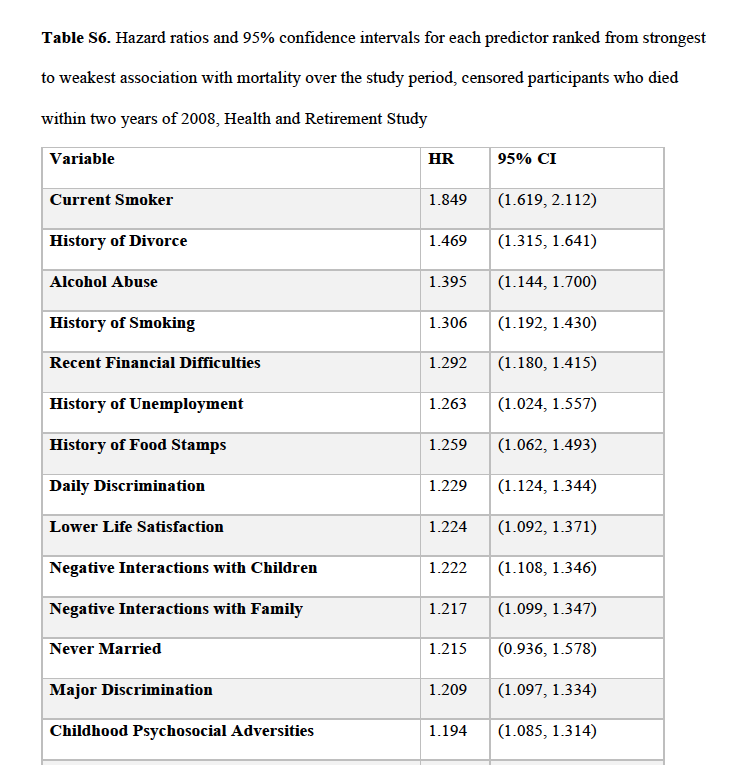If we have learned nothing else from COVID-19, becoming ill is the entanglement of biologic risk, like COVID’s need for ACE receptors, and non-biologic factors, like the population density, where you live, or the job you have. While many studies suggest that education and income are two modifiable non-biologic risks, the researcher here looked across a broad swarth of behavioral, financial, social, and psychologic “risks” to see which might have an effect size significant enough to pursue further.
They made use of the US Health and Retirement study a biannual survey of US adults age 50 or greater – about 14,000 adults gathered between 1992 and 2008 along with a 6-year follow-up for mortality. Yes, death as the outcome is a very broad brush, but remember, the goal of the study was to identify factors that researchers can dig deeper into with a reasonable hope of identifying useful concerns. To bolster confidence in their findings, the researchers also queried a second dataset, the Midlife in the United States Study (MIDUS), which contains a similar set of variables.
The researchers identified 57 variables across
“six commonly investigated domains in the behavioral and social sciences: (i) adverse socioeconomic and psychosocial experiences during childhood and (ii) socioeconomic conditions, (iii) health behaviors, (vi) social connections, (v) psychological characteristics, and (vi) adverse experiences during adulthood.”
Before going further, I can hear the screaming of my statistical colleagues that with that many variables, you can show just about anything you wish. Fair enough. But the researchers, mindful of that problem, utilized three very different statistical approaches to at least tamp down those concerns. [1]
The average study participants age were 69.3 years old, predominantly Caucasian (77%), American born, with a majority being women at 58%. The study was limited in that only people in the US were studied, and childhood experiences required recall. The most significant limitation was as the researcher clearly state, their findings are not causal and the impacts uncertain. But remember, the goal was to get us into the ballpark and identify the possible heavy hitters.
|
Risk Factor |
Hazard Ratio (Increased Risk) |
|
Current smoker |
1.91 |
|
Previous smoker |
1.32 |
|
History of Divorce |
1.44 |
|
History of Alcohol Abuse |
1.36 |
|
Recent Financial Difficulties |
1.32 |
|
History of unemployment |
1.32 |
|
Lower life satisfaction |
1.31 |
|
Never married |
1.30 |
|
History of using food stamps |
1.28 |
|
Negative Affectivity |
1.23 |
As many studies have already shown, being male increased your mortality risk, but the researchers did not identify any difference in these risks based on gender, ethnicity, or educational level. Age, of course, is one of the greatest risk factors for dying, as we collect more and more biologic risks so it will be no surprise that in the over- 75 participants had fewer significant non-biologic risks than in the under 75 crowd.
Gender, ethnicity, and place of birth explained almost 2% of the mortality variability, while “each domain independently provided an additional 1.1 to 4.7% increase in predictive power.” Because each domain included a range of variables, the researchers considered the top three in each. Here is the breakdown which all totaled, explains slightly more than 7% of the variance in mortality
|
Domain |
Increased Risk |
|
Behavioral factors |
4.4% |
|
Social connections |
1.9 |
|
Psychologic characteristics |
1.3% |
|
Adult socioeconomic conditions |
1.3% |
|
Adult adverse experiences |
1.2% |
|
Childhood factors |
0.7% |
Using their alternative statistical regressions childhood psychosocial adversity, which includes negative interactions with children, e.g., bullying also seemed to play a role as did household wealth.

For the sharp-eyed reader, searching for diet, environmental contaminants like pollution and pesticides, genetics, and routine health markers – they were not included. In many instances, they were not available, and the goal was to identify those risk factors most frequently collected in behavioral and social science studies.
Many of the risks overlap and confound one another. For example, financial difficulties often accompany unemployment and the need for food stamps, and all of them can contribute to lower life satisfaction. The researchers termed these interactions the social trajectory and recognized that even beginning to untie that Gordian knot was beyond the paper’s scope. While childhood economic risks did not appear to influence mortality, there is little doubt that for many of us, these early experiences lay “the ground for economic attainment, health habits, and personality in midlife and later in life.”
Adequate food, a stable, safe, home, neighborhood, and education are essential if not for our health than for our collective one. Most interesting is that it is our behavior, not our circumstances that play the most significant role, especially smoking. All of this suggests an old Buddhist thought, that while we cannot change what happens, we can control and somewhat effectively, how we respond.
[1] I would go into more detail as to the techniques, but it would reveal much of my statistical ignorance and is clearly beyond the reach of myself and general readers. Let’s just say that they tried to reduce those concerns and leave it to statisticians to determine how successful they were.
Source Predicting mortality from 57 economic, behavioral, social, and psychological factors PNAS DOI: 10.1073/pnas.1918455117




